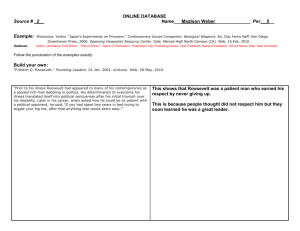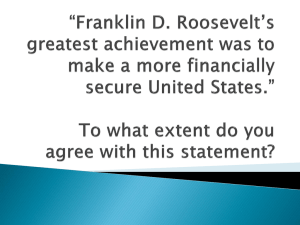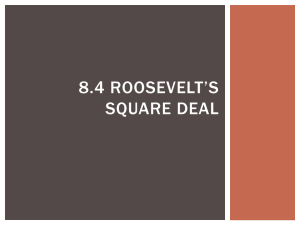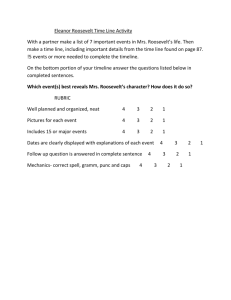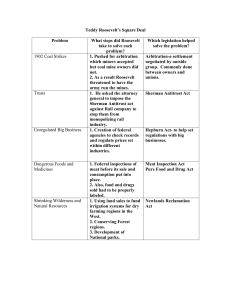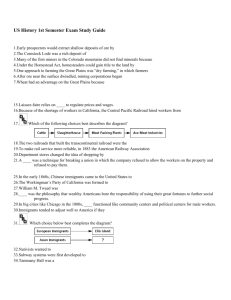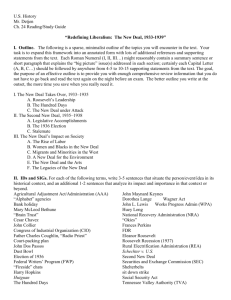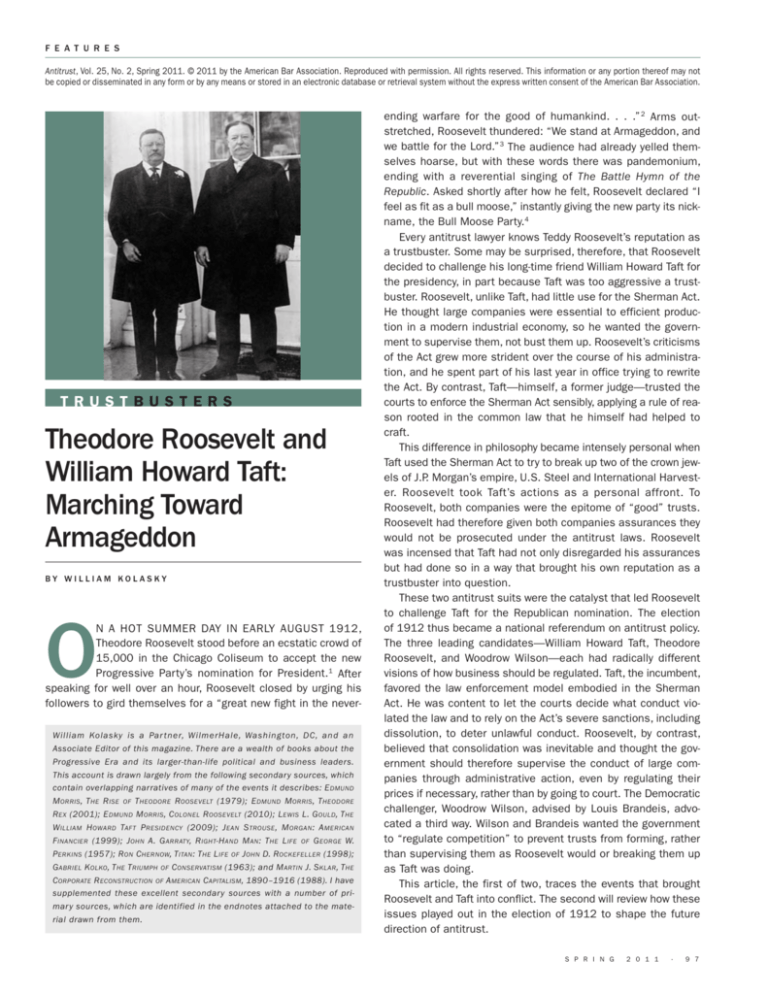
F E A T U R E S
Antitrust, Vol. 25, No. 2, Spring 2011. © 2011 by the American Bar Association. Reproduced with permission. All rights reserved. This information or any portion thereof may not
be copied or disseminated in any form or by any means or stored in an electronic database or retrieval system without the express written consent of the American Bar Association.
TRUSTBUSTERS
Theodore Roosevelt and
William Howard Taft:
Marching Toward
Armageddon
BY WILLIAM KOLASKY
O
N A HOT SUMMER DAY IN EARLY AUGUST 1912,
Theodore Roosevelt stood before an ecstatic crowd of
15,000 in the Chicago Coliseum to accept the new
Progressive Party’s nomination for President.1 After
speaking for well over an hour, Roosevelt closed by urging his
followers to gird themselves for a “great new fight in the neverWilliam Kolasky is a Par tner, WilmerHale, Washington, DC, and an
Associate Editor of this magazine. There are a wealth of books about the
Progressive Era and its larger-than-life political and business leaders.
This account is drawn largely from the following secondary sources, which
contain overlapping narratives of many of the events it describes: E DMUND
M ORRIS , T HE R ISE OF T HEODORE R OOSEVELT (1979); E DMUND M ORRIS , T HEODORE
R EX (2001); E DMUND M ORRIS , C OLONEL R OOSEVELT (2010); L EWIS L. G OULD, T HE
W ILLIAM H OWARD TAFT P RESIDENCY (2009); J EAN S TROUSE , M ORGAN : A MERICAN
F INANCIER (1999); J OHN A. G ARRATY, R IGHT-H AND M AN : T HE L IFE OF G EORGE W.
P ERKINS (1957); R ON C HERNOW, T ITAN : T HE L IFE OF J OHN D. R OCKEFELLER (1998);
G ABRIEL KOLKO , T HE T RIUMPH OF C ONSERVATISM (1963); and M ARTIN J. S KLAR , T HE
C ORPORATE R ECONSTRUCTION OF A MERICAN C APITALISM , 1890–1916 (1988). I have
supplemented these excellent secondary sources with a number of primar y sources, which are identified in the endnotes attached to the material drawn from them.
ending warfare for the good of humankind. . . .” 2 Arms outstretched, Roosevelt thundered: “We stand at Armageddon, and
we battle for the Lord.” 3 The audience had already yelled themselves hoarse, but with these words there was pandemonium,
ending with a reverential singing of The Battle Hymn of the
Republic. Asked shortly after how he felt, Roosevelt declared “I
feel as fit as a bull moose,” instantly giving the new party its nickname, the Bull Moose Party.4
Every antitrust lawyer knows Teddy Roosevelt’s reputation as
a trustbuster. Some may be surprised, therefore, that Roosevelt
decided to challenge his long-time friend William Howard Taft for
the presidency, in part because Taft was too aggressive a trustbuster. Roosevelt, unlike Taft, had little use for the Sherman Act.
He thought large companies were essential to efficient production in a modern industrial economy, so he wanted the government to supervise them, not bust them up. Roosevelt’s criticisms
of the Act grew more strident over the course of his administration, and he spent part of his last year in office trying to rewrite
the Act. By contrast, Taft—himself, a former judge—trusted the
courts to enforce the Sherman Act sensibly, applying a rule of reason rooted in the common law that he himself had helped to
craft.
This difference in philosophy became intensely personal when
Taft used the Sherman Act to try to break up two of the crown jewels of J.P. Morgan’s empire, U.S. Steel and International Harvester. Roosevelt took Taft’s actions as a personal affront. To
Roosevelt, both companies were the epitome of “good” trusts.
Roosevelt had therefore given both companies assurances they
would not be prosecuted under the antitrust laws. Roosevelt
was incensed that Taft had not only disregarded his assurances
but had done so in a way that brought his own reputation as a
trustbuster into question.
These two antitrust suits were the catalyst that led Roosevelt
to challenge Taft for the Republican nomination. The election
of 1912 thus became a national referendum on antitrust policy.
The three leading candidates—William Howard Taft, Theodore
Roosevelt, and Woodrow Wilson—each had radically different
visions of how business should be regulated. Taft, the incumbent,
favored the law enforcement model embodied in the Sherman
Act. He was content to let the courts decide what conduct violated the law and to rely on the Act’s severe sanctions, including
dissolution, to deter unlawful conduct. Roosevelt, by contrast,
believed that consolidation was inevitable and thought the government should therefore supervise the conduct of large companies through administrative action, even by regulating their
prices if necessary, rather than by going to court. The Democratic
challenger, Woodrow Wilson, advised by Louis Brandeis, advocated a third way. Wilson and Brandeis wanted the government
to “regulate competition” to prevent trusts from forming, rather
than supervising them as Roosevelt would or breaking them up
as Taft was doing.
This article, the first of two, traces the events that brought
Roosevelt and Taft into conflict. The second will review how these
issues played out in the election of 1912 to shape the future
direction of antitrust.
S P R I N G
2 0 1 1
·
9 7
F E A T U R E S
Theodore Roosevelt: Mixed Signals
On September 14, 1901, the anarchist Leon Czolgosz shot and
killed William McKinley at the Pan-American Exhibition in Buffalo,
New York. At the time, the Sherman Act was a virtual dead letter.
During his four-and-a-half years in office, from 1897 to 1901,
McKinley had brought just three actions to enforce the Act.
Meanwhile, the country experienced its first great merger wave.
From 1897 to 1904, 4,277 firms consolidated into 257, with the
hundred largest controlling over 40 percent of the country’s industrial capital.
This merger wave crested the same year McKinley was shot.
Earlier in 1901, J.P. Morgan organized the U.S. Steel Corporation,
the world’s first billion-dollar company. U.S. Steel combined, into
a single company, twelve of the largest steel producers in the
country, accounting for over 60 percent of the nation’s total steel
supply. Andrew Carnegie, whose Carnegie Steel company was the
cornerstone of the new company, later testified that when U.S.
Steel was being formed, “no one ever mentioned the antitrust
laws to me, that I remember.” 5
The man who succeeded to the presidency upon McKinley’s
death was already a larger-than-life figure. Just forty-three—
still the youngest man ever to serve as President—Theodore
Roosevelt already had done more than most men accomplish in
a lifetime. Admitted to Harvard College, where he studied natural history, Roosevelt became a member of both Porcellian and
Phi Beta Kappa, graduating 19th in a class of 230. After college,
he threw himself into New York State politics and was elected to
the state legislature at the age of twenty-four, the youngest legislator in the state’s history. Following his young wife’s death two
years later, Roosevelt spent three years pursuing the rugged life
in the West. He returned east in 1887 to run unsuccessfully for
mayor of New York. Roosevelt was then appointed Civil Service
Commissioner for the State of New York, where he served for six
years, earning a reputation as an ardent reformer. After a brief
stint as commissioner of the New York City police, Roosevelt was
appointed Assistant Secretary of the Navy by McKinley in 1897
as a reward for his tireless campaigning for the new president.
Despite this active record of public service, Roosevelt somehow
found time to write twenty-six books and more than a thousand
magazine articles over the course of his lifetime, before dying in
his sleep in 1919 at the age of sixty.
When the Spanish-American War broke out in 1898, Roosevelt
resigned his position as Assistant Secretary and organized a
cavalry regiment that became known as the Rough Riders.
Roosevelt gained a national reputation when he led his regiment’s
charge up San Juan Hill. Returning a national hero, Roosevelt easily won election as governor of New York, but quickly offended many
in the New York political establishment with his reform program.
In what many saw as an effort to get him out of New York,
Roosevelt’s opponents pushed for his nomination as vice president
for McKinley’s second term. Senator Mark Hanna initially resisted,
saying all too prophetically, “Don’t any of you realize there’s only
one life between that madman and the presidency?” 6 When
McKinley was assassinated just one year later, Hanna could not
help blurting out, “Now look, that damn cowboy is president!” 7
9 8
·
A N T I T R U S T
J.P. Morgan had known and admired Roosevelt’s father before
the latter’s premature death and had supported “Teddy” in his
first run for the New York state legislature. Morgan had also
given $10,000 to Roosevelt’s 1898 gubernatorial campaign and
was the guest of honor at a dinner hosted by Roosevelt after his
election as vice president. Morgan, however, was unsure of what
to expect from Roosevelt now that he was in the White House.
Therefore, just three weeks after McKinley’s death, Morgan asked
his new partner George Perkins to go to Washington to gauge
the new president’s views on trust policy, a subject on which
Roosevelt had been largely silent.
The House of Morgan was, at the time, the most powerful
bank in the United States. In addition to U.S. Steel, Morgan controlled General Electric, Western Union, Aetna, the Pullman Car
Company, the British Leyland Steamship Lines, and twenty-one
railroads. Perkins had just become one of Morgan’s partners
after a brilliant career at New York Life. Perkins soon became
known as Morgan’s Secretary of State, serving as his main
ambassador to Washington. Perkins had first met Roosevelt in
1900 when he successfully lobbied the then-Governor of New York
not to support legislation proposed by New York Life’s smaller
rivals to limit the company’s growth. Roosevelt, in return, asked
for Perkins’ help on one of his first conservation projects, appointing him to chair a commission to preserve the Palisades, across
the Hudson River from Manhattan. Perkins later played a role in
persuading Roosevelt to accept the Republican nomination for
vice president in 1900. When Roosevelt initially signaled that he
would decline the nomination, it was Perkins who persuaded
McKinley to tell Roosevelt that he had a public duty to accept, if
it were offered. Perkins then personally delivered McKinley’s message to Roosevelt, who—feeling he had no choice—accepted.
Perkins was a natural choice to feel out the new president
as to whether he would continue McKinley’s hands-off policy
toward trusts. Like Morgan, Perkins despised competition, believing that “size and business efficiency went hand in hand.” 8
Roosevelt shared a preliminary draft of his First Annual Message
to Congress with Perkins, along with another Morgan partner,
Robert Bacon, who had been a classmate of Roosevelt’s at
Harvard.9 After reading his draft, Perkins and Bacon pressed the
new President to take a more moderate line on the trust issue.
Roosevelt was noncommittal, but he wrote his brother-in-law that
while he considered both men to be “of the highest character
. . . on this particular occasion they were arguing like attorneys
for a bad case.” 10 Roosevelt did, however, later agree to soften
his tone, very much along the lines Perkins and Bacon had
suggested.
Roosevelt’s attitude toward trusts was critically important to
Morgan and his partners because Morgan was in the midst of trying to organize the Northern Securities Company, which would
bring together under one management the three main railroads
connecting the commercial center of Chicago to the Pacific Coast.
Morgan’s efforts had been triggered by a raid on one of his railroads, the Northern Pacific, by Edward H. Harriman, the head of
the Union Pacific, in May 1901. The raid caught Morgan, who was
vacationing in France at the time, by surprise. James J. Hill, the
head of the Great Northern Railway, worked with Morgan to thwart
Harriman’s raid. The raid, and the defensive moves by Morgan
and Hill, triggered a panic on Wall Street, which Morgan calmed
by agreeing to delay delivery of the shares he had purchased so
as to give short-sellers time to cover their positions. After Morgan
returned to the United States in July, he engineered a plan for permanent peace in the Northwest by proposing to form a giant holding company that would control the shares of the Northern
Pacific, the CB&Q, and the Great Northern. His attorneys cautioned him about the antitrust risk, saying, “What do you want to
do? Do you want to go to jail?” 11 Disregarding their advice,
Morgan chartered the new company, Northern Securities, on
November 12, 1901. Its directors included both Hill and
Harriman, as well as several of Morgan’s partners, including
Perkins. At the time of its formation, Northern Securities was the
second largest corporation ever formed (after U.S. Steel) with a
capitalization of $400 million.
When Roosevelt delivered his First Annual Message to
Congress in December 1901,12 just one month after Northern
Securities’ formation, Morgan and his partners must have felt
somewhat reassured. In it, Roosevelt defended the growing consolidation of American enterprise as resulting from “natural causes in the business world, operating in other countries as they
operate here.” 13 Noting that this process had “aroused much
antagonism,” Roosevelt found these fears “wholly without warrant.” 14 To the contrary, he argued that,
Never before has the average man. . . been so well off as in this
country and at the present time. . . . Successful enterprise, of the
type that benefits all mankind, can only exist if the conditions are
such as to offer great prizes as the rewards of success. The captains of industry . . . have on the whole done great good to our people. . . . The same business conditions which have produced the
great aggregations of corporate and individual wealth have made
them very potent factors in international commercial competition.
America has only just begun to assume that commanding positioning in the international business world which we believe will
more and more be hers.15
Trusts, therefore, should not be prohibited, but should be “supervised and within reasonable limits controlled.” 16
Morgan and his partners were therefore stunned two months
later when Roosevelt, without advance warning, filed suit to undo
the Northern Securities combination. Henry Adams wrote that
“our stormy petral of a president” had “suddenly, this week,
without warning, hit Pierpont Morgan, the whole railway interest,
and the whole Wall Street connection, a tremendous whack
square on the nose.” 17 (Adams always enjoyed poking fun at
Morgan’s nose, which resembled “a hideous purple bulb” due to
a severe case of rhinophyma.)
Roosevelt used a most unlikely messenger to deliver the
attack—his attorney general, Philander Knox.18 While in college in
Ohio, Knox began a lifelong friendship with William McKinley, who
was then district attorney in Stark County, Ohio. In 1901, McKinley
appointed Knox—who had become one of the wealthiest men in
Pennsylvania from his law practice in Pittsburgh—his attorney
general. Andrew Carnegie had been one of Knox’s largest clients,
and one of Knox’s last acts as a practicing lawyer had been to
draw up the papers transferring the Carnegie Steel Company to
U.S. Steel. Knox’s success in private practice belied his nickname, “sleepy Phil,” given him apparently because he was both
cross-eyed and tended to doze off during board meetings.
Morgan was so upset at Roosevelt’s action that he boarded
a train to Washington the next day to confront the new president
personally. Although he would be in Washington, Morgan declined
an invitation from Roosevelt to attend a dinner at the White
House for Prince Henry of Prussia, the brother of Kaiser Wilhelm.
The only extant account of Morgan’s meeting with Roosevelt and
Knox is a letter Roosevelt himself wrote Perkins. “If we have done
anything wrong,” he quoted Morgan as saying, “send your man to
my man and they can fix it up.” 19 Roosevelt replied, “That can’t
be done.” Knox added, “We don’t want to fix it up, we want to stop
it.” Morgan then asked, “Are you going to attack my other interests?” Roosevelt replied, “Certainly not, unless we find out they
have done something we regard as wrong.” 20
Roosevelt’s Détente with the House of Morgan
While Morgan and Perkins were unable to deflect Roosevelt’s suit
against Northern Securities, Roosevelt’s comments gave them
an opening to seek a détente. Four months later, in June 1902,
Perkins asked Roosevelt, Knox, and Roosevelt’s Secretary of
War, Elihu Root (a former Morgan lawyer), for their help in designing “some safe plan for us to adopt” in forming the International
Mercantile Marine Company. Morgan was seeking to combine
several major American flag shipping lines with British Leyland to
better compete with the other leading British line, Cunard. While
the three declined to comment, Roosevelt and Knox subsequently
allowed this combination to proceed without challenge.
That same month, on June 14, Perkins received a call from the
young John D. Rockefeller, Jr. Rockefeller told Perkins he had
been asked by some “Midwestern friends” for an opinion of one
of Morgan’s lawyers, Francis Stetson, as a “negotiator.” The
Midwesterners were three sons of Cyrus McCormick, inventor of
the reaper and founder of the McCormick Harvesting Company,
one of whom was married to Rockefeller’s sister. They were looking for someone to help them negotiate a merger with their competitors in order to end what they viewed as cut-throat competition in their industry. Perkins told Rockefeller that Stetson was
without peer as a lawyer but that his talents were less suitable
for the kind of “negotiating” the McCormicks had in mind. He suggested that they might do better talking with someone at Morgan
and offered to meet with them himself.
Perkins’ meeting with the McCormicks led to their retaining
the House of Morgan to put together a union of the leading farm
machinery producers, just as it had earlier done with the steel
industry. Within two months, Perkins and Morgan completed the
reorganization of the farm machinery industry, merging five of the
six largest manufacturers—which together produced over 85 percent of all harvesting machinery sold in the United States—into
a new corporation with a capitalization of $120 million. 21
Although Stetson had earlier warned the McCormicks of the danger of a government challenge to their merger, citing Roosevelt’s
S P R I N G
2 0 1 1
·
9 9
F E A T U R E S
Despite his détente with the House of Morgan, Roosevelt was able to
preser ve his reputation as a tr ustbuster by attacking John D. Rockefeller’s
Standard Oil combine with vigor. Standard Oil made an inviting target.
action against Northern Securities, Roosevelt and Knox also
allowed this consolidation to proceed unchallenged.
In his Second Annual Message to Congress,22 Roosevelt proposed a new Department of Commerce, something for which
business interests had been lobbying for nearly a decade. The bill
created a Bureau of Corporations within the Department, with
authority to conduct investigations and publish reports on the conduct of large companies. Perkins played such a key role in developing this legislation that Roosevelt gave him one of the pens he
used to sign the bill into law. Roosevelt then consulted one of
Morgan’s lawyers, Francis Stetson, about who should be his first
Commissioner of Corporations. At Stetson’s urging, Roosevelt
appointed James R. Garfield, the son of President James A.
Garfield and a close college friend of Stetson’s.
Roosevelt used the Bureau of Corporations primarily as a tool
to pressure large companies not to compete so aggressively as
to drive their smaller rivals out of business—the very antithesis
of what we would today regard as sound competition policy. Since
most companies needed little encouragement not to compete too
vigorously, Roosevelt found little need to enforce the Sherman
Act. Despite the favorable publicity generated by his attack on
Northern Securities, Roosevelt filed only four other antitrust
suits in the remainder of his first term, none against any of the
House of Morgan’s interests. Indeed, even when the Interstate
Commerce Commission found in May 1904 that International
Harvester had obtained illegal rebates from an Illinois railroad it
owned, Roosevelt’s new Attorney General William Moody agreed
not to prosecute the company in return for its promise to conform
to the law after being told when and where it was in violation.
Morgan personally contributed $100,000 to Roosevelt’s 1904
election campaign and encouraged others, including Frick,
Harriman, and Rockefeller, to do likewise. Immediately after the
election, Elbert Gary of U.S. Steel met with Roosevelt at the
White House and promised that the company would fully cooperate in any government investigation of its conduct, saying that
if Roosevelt ever found anything they had done that he thought
was wrong, the company would either convince him “that we are
right or we will correct the wrong.” Roosevelt responded, “Well,
that seems to me to be about the fair thing.” 23
Consistent with this understanding, Roosevelt personally intervened in August 1907 to head off a prosecution of the International Harvester Company. Congress had passed a resolution in
1 0 0
·
A N T I T R U S T
December 1906 ordering the Bureau of Corporations to investigate Harvester. In January 1907, Perkins and Gary met with
Garfield and his deputy, Herbert Knox Smith, in New York City to
discuss the investigation. Perkins and Gary told Garfield and
Smith that they would cooperate with the Bureau’s investigation,
which they welcomed because “the best thing that could happen
to the Harvester company was a report by the Bureau showing the
truth of their claim that they were operating their American business at a loss, for then they would have just ground for raising
American prices.”24 Two months later, Harvester asked Roosevelt’s
new Attorney General, Charles Bonaparte, to defer any prosecution until the Bureau completed its investigation. When Bonaparte
failed to respond, Perkins visited Roosevelt at his Oyster Bay
home in August. After meeting with Perkins, Roosevelt instructed
Bonaparte to hold off filing any action, writing that he had found
no “moral ground” for a Harvester prosecution.
Roosevelt’s Assault on Standard Oil
Despite his détente with the House of Morgan, Roosevelt was
able to preserve his reputation as a trustbuster by attacking
John D. Rockefeller’s Standard Oil combine with vigor. Standard
Oil made an inviting target. Its early success in combining a
large number of small refiners into one giant trust, often through
shotgun marriages arranged after episodes of local price cutting,
had been one of the principal reasons for the original enactment
of the Sherman Act. And in 1904, Ida Tarbell—whose father had
been driven out of the oil business by Standard Oil—had reopened these old wounds with a series of muckraking articles in
McLure’s Magazine, later reprinted in a best-selling book entitled
The History of Standard Oil, that portrayed Standard Oil and its
founder, John D. Rockefeller, as the devil incarnate. To compound
its problems, Standard Oil—unlike the House of Morgan—had
resisted Roosevelt’s will by opposing the creation of the Bureau
of Corporations. After the Bureau was in place, Standard Oil—
again unlike the Morgan companies—reneged on pledges of
cooperation with Bureau investigations, much to Garfield’s and
Roosevelt’s irritation. In Roosevelt’s eyes, Standard Oil’s history
and its lack of cooperation made it the epitome of an “evil”
trust, just as Morgan’s companies were models of “good” trusts.
In mid-November 1906, Roosevelt authorized the Justice
Department to file multiple cases against Standard Oil and its
affiliates, accusing them of receiving illegal rebates from rail-
roads. Less than a year later, in August 1907, Judge Kenesaw
Mountain Landis—who later gained fame as the baseball commissioner who expelled Shoeless Joe Jackson from baseball in
the 1919 Black Sox scandal—found Standard Oil guilty and fined
it $29.2 million. Rockefeller, then nearly seventy, showed his
sang froid when he was informed of the fine. Rockefeller was playing golf when a messenger came running onto the course to deliver the news. After reading the telegram, Rockefeller put it in his
pocket and then hit a perfect drive down the middle of the fairway, ending the day with his best score ever. Later in the round,
when one of his playing companions asked about the message,
Rockefeller responded that Judge Landis would be dead long
before the fine was paid—a prediction that proved accurate as
the court of appeals threw out the fine a year later.
In September 1907, fresh on the heels of his victory in the
rebate case, Roosevelt filed suit to dissolve Standard Oil. On
September 21, Standard Oil approached Garfield, offering to
reorganize the company if the antitrust suit could be quashed. On
September 27, Garfield discussed the proposal with Roosevelt,
who agreed they should study any proposal formally submitted by
the company’s senior management. Standard Oil’s president,
John Archbold, and John D. Rockefeller formally submitted their
proposal two days later, which Roosevelt and Bonaparte seriously
studied over the next month. But then Standard made a fatal
error. Senator Jonathan Bourne of Oregon visited Roosevelt and
told him that if he agreed to the proposal, the oil giant would help
him win the nomination for president in 1908. On October 25,
Roosevelt met with his Cabinet and announced that he had
decided to continue the lawsuit.
Roosevelt brought his only other major Sherman Act monopolization case, against American Tobacco, in July 1907. Like
Standard Oil, American Tobacco tried unsuccessfully to head off
the suit by offering to divest its stock in British American Tobacco,
R.J. Reynolds, and others. The future Supreme Court Justice
James McReynolds, who was handling the matter as a special
assistant to the Attorney General, pressed for putting American
Tobacco into receivership and prosecuting its founder, James
Duke, criminally under the Sherman Act. At the urging of Elihu
Root and others in the administration, Roosevelt declined to
seek such extreme remedies, but nevertheless authorized a civil
action seeking the company’s dissolution.
Roosevelt Allows Morgan to Acquire
Tennessee Coal & Iron
Roosevelt’s action against American Tobacco, followed shortly by
Landis’ $29 million fine against Standard Oil, helped trigger a
panic on Wall Street. The U.S. stock market crashed on August
10, 1907, producing losses of over $1 billion. J.P. Morgan’s son,
Jack Morgan, echoed general Wall Street sentiment in blaming
the crash on government “attacks” on big business—”everyone
is frightened to death by the action of people like our fool
Attorney General.” 25
J.P. Morgan is generally credited with having almost singlehandedly brought the panic under control three months later in
early November 1907. But just as the panic seemed to be sub-
siding, rumors began circulating that another New York investment firm, Moore & Schley, was near collapse. Moore & Schley,
whose principal asset was its large shareholding in Tennessee
Coal & Iron (TCI), asked U.S. Steel for a loan of $1.2 million to
stave off its bankruptcy. U.S. Steel agreed to make the loan, taking $2 million in TCI common stock as collateral. As the markets
continued to fall, Moore & Schley told Morgan it needed another
$5–6 million to meet its obligations and offered to sell all its TCI
shares to U.S. Steel. On Sunday, November 2, at Morgan’s urging, U.S. Steel’s finance committee agreed to buy Moore &
Schley’s TCI shares for $12 million, but only on the condition that
they could get some assurance from Roosevelt that the government would not seek to block their acquisition.
Elbert Gary called the White House at 10 p.m. that evening to
set up a meeting with Roosevelt, and two hours later he and
another senior Steel executive, Henry Frick, boarded the midnight
train for Washington. The next morning they met with Roosevelt,
Garfield, and Root over breakfast at the White House. Gary and
Frick told Roosevelt that unless U.S. Steel acquired TCI’s stock,
an important investment bank would collapse, triggering a major
crisis on Wall Street. Roosevelt responded that he felt “no public duty” to interpose any objection to their acquisition of TCI and
so instructed his attorney general in a letter drafted by Gary and
Root.
After he left office, Roosevelt’s action became the subject of
two contentious congressional investigations. A 1909 Senate
Judiciary Committee investigation concluded that the acquisition had allowed U.S. Steel to gain control of the country’s ironore supply and open-hearth rail production and had given it a
monopoly of the iron and steel trade in the south by eliminating
a “strong and growing competitor.” Two years later, in 1911, after
the Democrats had won control of Congress in the midterm elections, a special House committee known as the Stanley Steel
Trust Investigating Committee held further hearings on the deal,
which made newspaper headlines for months. Roosevelt, against
Taft’s advice, appeared at these hearings to defend his actions
as having been necessary to end the 1907 financial panic. “If I
were on a sailboat,” he argued, “I should not ordinarily meddle
with any of the gear; but if a sudden squall struck us and the
main sheet jammed so that the boat threatened to capsize, I
would unhesitatingly cut the main sheet.” 26 Predictably, the
Stanley Committee’s final report split along party lines.27 The
Democratic majority accused Roosevelt of having aided and abetted Morgan’s effort to further monopolize the steel industry,
while the Republicans defended his action as necessary to end
a serious financial panic.
The Gary Dinners
Perhaps emboldened by Roosevelt’s agreement not to object to
its purchase of TCI, Elbert Gary almost immediately embarked on
an effort to stabilize prices in the steel industry, organizing the
infamous “Gary dinners.” 28 Just two weeks later, on Nov. 21,
1907, Gary invited forty-nine key steel industry leaders to the
Waldorf-Astoria in New York. At this first dinner, Gary gave the
keynote speech, stressing the importance of industry cooperation
S P R I N G
2 0 1 1
·
1 0 1
F E A T U R E S
and warning of the need to avoid “becoming panic stricken”
resulting in “too great a cut in prices.” 29 Although the participants
later protested that no agreements had been reached to fix
prices, they acknowledged that they had left the dinners with an
understanding that they should not undercut each other’s prices
to win business.
The Gary dinners continued for a little more than a year, ending (perhaps not coincidentally) just before Roosevelt left office.
Beginning in June 1908, the understandings reached at the dinners began to break down, as smaller companies began cutting
prices, and the larger companies were forced to meet this competition. In February 1909, the major steel companies met one
last time, admitted they had all cut prices to meet competition,
and formally terminated the Gar y dinners. Lawyers from
Roosevelt’s Justice Department had known of the dinners all
along but interposed no objection to them.
Roosevelt Tries to Rewrite the Sherman Act
In his penultimate Message to Congress in December 1907,
Roosevelt stepped up his attacks on the Sherman Act. Calling for
new legislation, Roosevelt declared that,
I believe . . . it is worse than folly to attempt to prohibit all combinations as is done by the Sherman antitrust law, because such a
law can be enforced only imperfectly and unequally, and its enforcement works almost as much hardship as good. . . . [I]nstead of an
unwise effort to prohibit all combinations there shall be substituted a law which shall expressly permit combinations which are in the
interest of the public, but shall at the same time give to some
agency of the national government full power of control and supervision over them.30
Following up on Roosevelt’s message, Representative William
Hepburn of Iowa introduced legislation in March 1908 designed
to incorporate Roosevelt’s ideas into law. The Hepburn bill, which
was drafted with the active participation of both Stetson and
Perkins from the House of Morgan, would have allowed any corporation voluntarily to register with the Bureau of Corporations.
Once a company registered, it could submit any proposed contract or merger for review. If the Bureau did not declare the proposal illegal within thirty days, the government would be denied
the right to prosecute the company under the Sherman Act
unless the contract unreasonably restrained trade. Although
Roosevelt himself was heavily involved in shaping the final version of the bill, he refrained from throwing his full support behind
it until he could see how it was received. On that score, the verdict was decisive. When the bill was introduced, there was an outpouring of criticism accusing Roosevelt of seeking total control
over the entire economy.31 Facing an overwhelmingly negative
reaction, Roosevelt let the bill die a quiet death.
William Howard Taft: True Believer
When he was elected to his first full term as president in 1904,
Roosevelt made what he later called “the worst political blunder”
of his life: he announced he would honor the tradition established
by George Washington of serving no more than two terms and
would not seek reelection in 1908. In 1908, feeling bound to
honor this vow, Roosevelt picked as his successor his Secretary
1 0 2
·
A N T I T R U S T
of the Army and close friend and advisor, William Howard Taft.
“Will” Taft was born in 1857, one year after Roosevelt. His
father, Alfonso Taft, was Ulysses S. Grant’s last attorney general. Taft graduated from Yale in 1878, where he was elected to
Skull & Bones and finished second in his class. Returning home
to Ohio, he studied law at the Cincinnati Law School and was
admitted to the Ohio bar in 1881. After serving briefly as a judge
of the Ohio Superior Court, Taft was appointed Solicitor General
by Benjamin Harrison in 1890, the year the Sherman Act became
law, when he was only thirty-three. While Solicitor General, Taft,
as Acting Attorney General, authorized the very first Sherman
Act complaint, United States v. Jellico Mountain Coke & Coal Co.32
The complaint, which was filed in the federal circuit court in
Nashville, Tennessee, alleged that various coal-mining companies
operating in Kentucky and Tennessee had formed the Nashville
Coal Exchange to fix the price and output of coal. The court
found in favor of the government, holding that the Exchange violated the Act and enjoining its further operation.
In 1892, President Harrison appointed Taft to the U.S. Court
of Appeals for the Sixth Circuit, where he served for eight years,
during which he authored one of our most notable antitrust opinions, United States v. Addyston Pipe Co.33 In his opinion, Judge Taft
first surveyed the history of how restraints of trade had been
treated at common law. He then crafted a rule under which a
restraint that was ancillary to an otherwise legitimate joint
endeavor would be lawful so long as it was reasonably necessary
to that joint enterprise. This ancillary restraints doctrine later
helped provide the analytical framework for the rule of reason
that Chief Justice Edward Douglass White enunciated in the
Standard Oil case while Taft was president.
President William McKinley appointed Taft governor general of
the Philippines in 1901. In 1902, Roosevelt, who had known Taft
from his time in Washington as Solicitor General, offered Taft a
seat on the Supreme Court. Taft declined on the grounds that his
work on the islands was not complete. Roosevelt then offered the
seat to Oliver Wendall Holmes, a choice he soon regretted when
Holmes dissented in Northern Securities.34 Two years later, in
early 1904, Roosevelt appointed Taft Secretary of War, replacing
Elihu Root, who returned to his law practice in New York, representing, among others, the House of Morgan. Over the next four
years, Taft served as an all-purpose troubleshooter for the
President, undertaking missions to the Far East, helping maintain
order in Cuba, and overseeing construction of the Panama Canal.
In the winter of 1906, Roosevelt again offered Taft a seat on
the Supreme Court. Taft again declined, this time purportedly
because of the work he was doing in the War Department, but
more likely because the opening was not for Chief Justice. With
Roosevelt’s support, Taft easily won the Republican nomination
for President in 1908. He went on to win the general election,
beating the Great Commoner William Jennings Bryant by a 2-to1 margin in the Electoral College. It was only the second elective
office Taft had run for, the first being an Ohio state court judgeship in 1888.
Taft’s one-term presidency is generally viewed as a failure, but
it may have marked a high water mark for antitrust enforcement.
Taft’s one-ter m presidency is generally viewed as a failure, but it may have
mar ked a high water mar k for antitr ust enforcement. Both Taft and his
attor ney general, George Wicker sham, were fer vent believer s in the
Sher man Act. Both were unafraid to take on strong business interests,
including even the House of Morgan.
Both Taft and his attorney general, George Wickersham, were fervent believers in the Sherman Act. Both were unafraid to take on
strong business interests, including even the House of Morgan.
In just four years, Taft and Wickersham initiated seventy-eight
antitrust suits, nearly double the forty-four Roosevelt had brought
during his seven years in office.35 More importantly, while all but
a handful of Roosevelt’s actions were Section 1 complaints
against small local price-fixing rings, Taft and Wickersham brought
almost a dozen major Section 2 complaints accusing some of
the mightiest companies in the country of monopolizing the markets in which they competed. His targets included households
names such as U.S. Steel, International Harvester, General Electric, United Shoe Machinery, Alcoa, American Sugar Refining,
Corn Products Refining, National Cash Register, American Thread,
and American Coal Products.
Taft and Wickersham’s crusade to enforce the Sherman Act
received a critical boost in May 1911 when the Supreme Court,
led by Taft’s newly-appointed Chief Justice, Edward Douglass
White, ruled in favor of the government in the Standard Oil 36 and
American Tobacco 37 cases, enunciating a rule of reason for applying the Sherman Act that had its roots in Taft’s own opinion in
Addyston Pipe.38 Just as Taft had done, White derived his rule of
reason from a survey of the common law treatment of restraints
of trade, borrowing heavily from Taft’s earlier opinion. Emboldened
by the Court’s twin rulings, Taft and Wickersham brought fifty-eight
antitrust actions during their last two years in office.
Taft and Wickersham’s aggressive enforcement of the Sherman
Act alienated much of the business community. Businessmen
“pleaded with Taft to restore business confidence by withholding
further antitrust actions.”39 Taft ignored their pleas, and Wickersham continued to bring new and even bigger cases. Two of
these, against two crown jewels of the Morgan empire, U.S. Steel
and International Harvester, ended Taft’s long friendship with
Roosevelt and led directly to Roosevelt challenging Taft for the
Republican nomination for President in 1912.
Wickersham filed his action against U.S. Steel on October 26,
1911. His complaint sought the company’s dissolution, alleging
that its initial formation in 1901 had violated both Sections 1 and
2 of the Sherman Act, and that the company had engaged in a
pattern of conduct over the ensuing decade designed to maintain
its monopoly. In a direct attack on Roosevelt, the complaint
alleged that U.S. Steel’s 1907 acquisition of Tennessee Coal &
Iron had been part of this ongoing effort. It suggested that
Roosevelt had been duped when he allowed that purchase to proceed because he “was not made fully acquainted with the state
of affairs in New York relevant to the transaction as they existed.” 40 Wickersham recognized that this claim would amount to
“an open declaration of war” on Roosevelt, but proceeded nevertheless.
The next morning, the New York Times carried the story on its
front-page with a giant headline reading “Government Sues To
Dissolve Steel Trust As Illegal Combination In Restraint Of Trade,”
followed by the line “Says Roosevelt Was Deceived.” 41 As
Wickersham had anticipated, Roosevelt was enraged. Writing to
his son, Roosevelt complained that Taft and Wickersham were
“playing small, mean and foolish politics with this matter.” 42
Roosevelt immediately broke off all relations with Taft and
published a long article in Outlook defending his actions.43
Writing that he “went over every detail of the trust situation” with
his Commissioner of the Bureau of Corporations, James Garfield,
Roosevelt quoted at length from a letter Garfield wrote him saying that “our papers give nothing that indicates any kind of unfair
or dishonest competition such as existed in both the Standard
Oil and Tobacco cases.”44 Roosevelt added that Taft had been a
member of his cabinet at the time and had not “protested
against, and as far as I knew approved of my action in this case,
as in the Harvester Trust case, and all similar cases.” Roosevelt
went on to defend his overall antitrust record. Before he took
office, he wrote, “there had been little real enforcement of the
Anti-Trust law,” and the law was widely regarded “as a dead letter.” 45 He therefore had found it “imperative to teach the masters
of the biggest corporations in the land that they were not . . .
above the law,” but he emphasized that “the corporations against
which we proceeded had sinned, not merely by being big (which
we did not regard as in itself a sin), but by being guilty of unfair
practices towards their competitors.” 46 By contrast, Roosevelt
charged that Taft’s policy toward big business was “chaotic.”
Roosevelt contended that,
We should not strive for a policy of unregulated competition and of
the destruction of all big corporations, that is, of all the most efficient business industries in the land. Nor should we persevere in
the hopeless experiment of trying to regulate these industries by
S P R I N G
2 0 1 1
·
1 0 3
F E A T U R E S
means only of lawsuits . . . . We should enter upon a course of
supervision, control, and regulation of these great corporations—
a regulation which we should not fear, if necessary, to bring to the
point of control of monopoly prices, just as in exceptional cases
railway rates are regulated.47
After publishing his Outlook article in December, Roosevelt let it
be known that he might be willing to run for a third term after all.
Four months later, while Roosevelt and Taft were locked in a
fierce battle for the Republican nomination, Wickersham struck at
Roosevelt a second time. On April 12, 1912, Wickersham filed a
monopolization action against Morgan’s International Harvester
Corporation, once again disregarding assurances Roosevelt had
given to the House of Morgan in 1907. This time, Wickersham
simultaneously released a collection of documents detailing
Roosevelt’s promises not to prosecute Harvester, thus further
exposing the cozy relationship between Roosevelt and the House
of Morgan. The next day, The New York Times ran a lead story with
the headline, “Roosevelt Held Back Trust Suit,” followed by a line
saying that Roosevelt had “heeded Perkins’s plea” not to prosecute the company.48 Roosevelt, his reputation as a trustbuster
again under attack, counterattacked by claiming that Taft had
been at the Cabinet meeting at which the decision to postpone
the prosecution had been made. Taft denied the charge, saying
that he had been out of the country in the Philippines at the
time.
Plainly, Roosevelt—who honestly believed his reputation as a
trustbuster—could not tolerate his hand-picked successor calling
that record into question and making him appear to be a Morgan
puppet. Armageddon was only a short march away. 䡵
1
2
See John Schmidt, Bull Moose (8-6-1912), C HICAGO N OW (Aug. 6, 2010, 6:46
AM), http://www.chicagonow.com/blogs/unknown-chicago/2010/08/bullmoose-8-6-1912.html.
Theodore Roosevelt, A Confession of Faith, Address to the Progressive Party
Convention (Aug. 6, 1912), http://www.teachingamericanhistory.org/
library/index.asp?document=613.
17
S TROUSE , supra note 8, at 440.
18
For a brief sketch of Knox’s career, see Philander Chase Knox—Biography,
http://www.answers.com/topic/philander-c-knox.
19
S TROUSE , supra note 8, at 440–41.
20
Id.
21
See United States v. Int’l Harvester Co., 214 F. 987, 990–91 (D. Minn.
1914).
22
Theodore Roosevelt, Second Annual Message to the Senate and House
of Representatives (Dec. 2, 1902), John Woolley & Gerhard Peters, The
American Presidency Project, http://www.presidency.ucsb.edu/ws/?pid=
29543.
23
G ABRIEL K OLKO, T HE T RIUMPH
24
Id. at 120.
25
S TROUSE , supra note 8, at 440–41.
26
Id.
27
See Diverse Trust Views in Stanley Report; Democrats and Republicans Split
Hopelessly over Tennessee Coal and Iron Deal, N.Y. T IMES , July 24, 1912, at
1, available at http://query.nytimes.com/gst/abstract.html?res=F70A12
FD395813738DDDAD0A94DF405B828DF1D3.
28
See United States v. U.S. Steel Corp., 223 F.55, 154–61 (D.N.J. 1915).
29
Id. at 156.
30
Theodore Roosevelt, Eighth Annual Message to Congress (Dec. 8, 1907),
http://teachingamericanhistory.org/library/index.asp?documentprint=941.
31
See, e.g., Amending the Anti-Trust Act, N.Y. T IMES , Mar. 24, 1908, at 1,
available at http://query.nytimes.com/mem/archive-free/pdf?res=F50611
FA345E13738DDDA80A94DC405B838DF1D3 (editorializing that the measure seemed “intended to enable President Roosevelt to accomplish by indirection what he very well knows he could not get by express authorization
of Congress, the power to regulate and control all corporation business of
the country by a system of registration or license, a power which he has
repeatedly asked Congress to confer on him”).
32
43 F.898 (C.C. Tenn. 1890); see U.S. C OURTS , T HE F EDERAL A NTITRUST L AW
WITH A MENDMENTS 20 (1914).
33
85 F.271 (6th Cir. 1898).
34
United States v. Northern Sec. Co., 193 U.S. 197, 364 (1904) (Holmes, J.,
dissenting). See William Kolasky, Edward Douglass White and the Birth of
the Rule of Reason, A NTITRUST , Summer 2010, at 77.
35
For a complete list of cases instituted by Roosevelt and Taft, see U.S.
C OURTS , supra note 35, at 26–55.
36
Standard Oil Co. v. United States, 221 U.S. 1 (1911).
37
United States v. Am. Tobacco Co., 221 U.S. 106 (1911).
OF
C ONSERVATISM 79 (1963).
3
See Schmidt, supra note 1.
38
United States v. Addyston Pipe & Steel Co., 85 F.271 (6th Cir. 1898).
4
Id.
39
K OLKO , supra note 23, at 168.
5
See R ICHARD S. T EDLOW, G IANTS OF E NTERPRISE : S EVEN B USINESS I NNOVATORS
AND THE E MPIRES T HEY B UILT 3 (2001).
40
L EWIS L. G OULD, T HE W ILLIAM H OWARD TAFT P RESIDENCY 167 (2009).
41
See Files Suit to Dissolve Steel Trust; Government Takes Long-Expected Action
to Declare Billion-Dollar Corporation Illegal, N.Y. T IMES , Oct. 27, 1911,
available at http://query.nytimes.com/mem/archive-free/pdf?res=FA0D1
EFE395517738DDDAE0A94D8415B818DF1D3.
42
G OULD , supra note 40, at 168.
43
See Theodore Roosevelt, The Trusts, The People, and The Square Deal,
O UTLOOK , Nov. 18, 1911, reprinted in T HEODORE R OOSEVELT, T HEODORE
R OOSEVELT : A N A UTOBIOGRAPHY 606–20 (1913).
44
Id. at 602, 607.
45
Id. at 609.
46
Id. at 610.
47
Id.
48
See Roosevelt Held Back Trust Suit, N.Y. T IMES , Apr. 24, 1912, at A1,
available at http://query.nytimes.com/gst/abstract.html?res=F10717FF3E
5813738DDDAC0A94DC405B828DF1D3.
6
EDMUND MORRIS, THE RISE OF THEODORE ROOSEVELT 763 (1979).
7
E DMUND M ORRIS , T HEODORE R EX 30 (2001).
8
J EAN S TROUSE , M ORGAN : A MERICAN F INANCIER 411 (1999).
9
Only a year later, Bacon—worn out by the pressure of working for Morgan
on the organization of U.S. Steel and other trusts and by a bitter rivalry with
Perkins for Morgan’s favor—suffered a nervous breakdown and, after a
leave of absence, resigned his partnership.
10
11
12
S TROUSE , supra note 8, at 439.
Id. at 427.
Theodore Roosevelt, First Annual Message to Congress (Dec. 3, 1901),
http://teachingamericanhistory.org/library/index.asp?documentprint=940.
13
Id.
14
Id.
15
Id.
16
Id.
1 0 4
·
A N T I T R U S T

